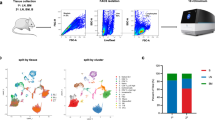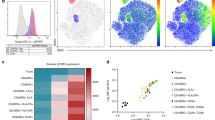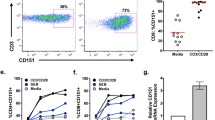Abstract
Antigen stimulation of lymphocytes induces upregulation of phospholipase D (PLD) activity, but the biological significance of PLD-mediated signaling in T cells has not been well established. Here we demonstrate that PLD signaling is essential for proliferation of mouse CD8+ T cells and CD4+CD25− T cells, but is not required for proliferation of CD4+CD25+ regulatory T cells. We exploited this observation to develop an efficient method to enrich for regulatory T cells starting from preparations of total CD4+ T lymphocytes. Inhibition of PLD signaling blocked effector T-cell proliferation after T cell–antigen receptor (TCR) engagement, but had no significant effect on the proliferation of CD4+CD25+ T cells with regulatory functions. Consequently, cells expanded in vitro for one week by antigen receptor stimulation with PLD signal inhibition were markedly enriched for regulatory T cells.
This is a preview of subscription content, access via your institution
Access options
Subscribe to this journal
Receive 12 print issues and online access
$259.00 per year
only $21.58 per issue
Buy this article
- Purchase on Springer Link
- Instant access to full article PDF
Prices may be subject to local taxes which are calculated during checkout






Similar content being viewed by others
References
Melendez, A.J. & Allen, J.M. Phospholipase D and immune receptor signaling. Semin. Immunol. 14, 49–55 (2002).
Exton, J.H. Phospholipase D structure, regulation and function. Rev. Physiol. Biochem. Pharmacol. 144, 1–94 (2002).
Andresen, B.T., Rizzo, M.A., Shome, K. & Romero, G. The role of phosphatidic acid in the regulation of the Ras/MEK/Erk signaling cascade. FEBS Lett. 531, 65–68 (2002).
Yang, C. & Kazanietz, M.G. Divergence and complexities in DAG signaling: looking beyond PKC. Trends Pharmacol. Sci. 24, 602–608 (2003).
Liu, G.L., Shaw, L., Heagerty, A.M., Ohanian, V. & Ohanian, J. Endothelin-1 stimulates hydrolysis of phosphatidylcholine by phospholipases C and D in intact rat mesenteric arteries. J. Vasc. Res. 36, 35–46 (1999).
Frohman, M.A., Sung, T.C. & Morris, A.J. Mammalian phospholipase D structure and regulation. Biochim. Biophys. Acta 1439, 175–186 (1999).
McDermott, M., Wakelam, M.J. & Morris, A.J. Phospholipase D. Biochem. Cell Biol. 82, 225–253 (2004).
Colley, W.C. et al. Phospholipase D2, a distinct phospholipase D isoform with novel regulatory properties that provokes cytoskeletal reorganization. Curr. Biol. 7, 191–201 (1997).
Sung, T.C. et al. Mutagenesis of phospholipase D defines a superfamily including a trans–Golgi viral protein required for poxvirus pathogenicity. EMBO J. 16, 4519–4530 (1997).
Sugars, J.M., Cellek, S., Manifava, M., Coadwell, J. & Ktistakis, N.T. Fatty acylation of phospholipase D1 on cysteine residues 240 and 241 determines localization on intracellular membranes. J. Biol. Chem. 274, 30023–30027 (1999).
Xie, Z., Ho, W.T. & Exton, J.H. Requirements and effects of palmitoylation of rat PLD1. J. Biol. Chem. 276, 9383–9391 (2001).
Czarny, M. et al. Phospholipase D2: functional interaction with caveolin in low–density membrane microdomains. FEBS Lett. 467, 326–332 (2000).
Morris, A.J., Frohman, M.A. & Engebrecht, J. Measurement of phospholipase D activity. Anal. Biochem. 252, 1–9 (1997).
Biffen, M., Shiroo, M. & Alexander, D.R. Selective coupling of the T cell antigen receptor to phosphoinositide-derived diacylglycerol production in HPB-ALL T cells correlates with CD45–regulated p59fyn activity. Eur. J. Immunol. 23, 2980–2987 (1993).
Mollinedo, F., Gajate, C. & Flores, I. Involvement of phospholipase D in the activation of transcription factor AP-1 in human T lymphoid Jurkat cells. J. Immunol. 153, 2457–2469 (1994).
Reid, P.A., Gardner, S.D., Williams, D.M. & Harnett, M.M. The antigen receptors on mature and immature T lymphocytes are coupled to phosphatidylcholine-specific phospholipase D activation. Immunology 90, 250–256 (1997).
Sakaguchi, S. Naturally arising Foxp3-expressing CD25+CD4+ regulatory T cells in immunological tolerance to self and non-self. Nat. Immunol. 6, 345–352 (2005).
Tijsterman, M. & Plasterk, R.H. Dicers at RISC; the mechanism of RNAi. Cell 117, 1–3 (2004).
Fontenot, J.D. & Rudensky, A.Y. A well adapted regulatory contrivance: regulatory T cell development and the forkhead family transcription factor Foxp3. Nat. Immunol. 6, 331–337 (2005).
Singh, B. et al. Control of intestinal inflammation by regulatory T cells. Immunol. Rev. 182, 190–200 (2001).
Ochs, H.D., Ziegler, S.F. & Torgerson, T.R. FOXP3 acts as a rheostat of the immune response. Immunol. Rev. 203, 156–164 (2005).
Mellor, A.L. et al. Cutting edge: induced indoleamine 2,3 dioxygenase expression in dendritic cell subsets suppresses T cell clonal expansion. J. Immunol. 171, 1652–1655 (2003).
Taniguchi, T. & Minami, Y. The IL-2/IL-2 receptor system: a current overview. Cell 73, 5–8 (1993).
Yamasaki, S., Takamatsu, M. & Iwashima, M. The kinase, SH3, and SH2 domains of Lck play critical roles in T-cell activation after ZAP-70 membrane localization. Mol. Cell. Biol. 16, 7151–7160 (1996).
Gavin, M.A., Clarke, S.R., Negrou, E., Gallegos, A. & Rudensky, A. Homeostasis and anergy of CD4(+)CD25(+) suppressor T cells in vivo. Nat. Immunol. 3, 33–41 (2002).
Tang, Q. et al. In vitro–expanded antigen-specific regulatory T cells suppress autoimmune diabetes. J. Exp. Med. 199, 1455–1465 (2004).
Horwitz, D.A., Zheng, S.G. & Gray, J.D. The role of the combination of IL-2 and TGF-β or IL-10 in the generation and function of CD4+ CD25+ and CD8+ regulatory T cell subsets. J. Leukoc. Biol. 74, 471–478 (2003).
Mage, M.G. In vitro assays for mouse lymphocyte function. In Current Protocols in Immunology (eds., Coligan, J.E., Kruisbeek, A.M., Margulies, D.H., Shevach, E.M. & Strober, S.) 3.5.1–3.5.6 (John Wiley & Sons, Indianapolis, 1993).
Iwashima, M. et al. Genetic evidence for Shc requirement in TCR-induced c-Rel nuclear translocation and IL-2 expression. Proc. Natl. Acad. Sci. USA 99, 4544–4549 (2002)..
Zheng, X., Ray, S. & Bollag, W.B. Modulation of phospholipase D–mediated phosphatidylglycerol formation by differentiating agents in primary mouse epidermal keratinocytes. Biochim. Biophys. Acta 1643, 25–36 (2003).
Acknowledgements
We thank A. Weiss and D.H. Munn for critical reading of the manuscript, T. Tada for encouragement, M. Frohman and Y. Kanaho for reagents, MCG flow Cytometry Core and Histology core for support, and A. Sridhar, M. Takezaki and D. McCool for assistance. This work is supported by US National Institutes of Health grants AI055022 and AI049398 (to M.I), and AR45212 and HL70046 (to W.B.B.).
Author information
Authors and Affiliations
Corresponding author
Ethics declarations
Competing interests
N.S. and M.I. are authors of a pending patent (application number US 60-625403), which covers the work described in this article.
Supplementary information
Supplementary Fig. 1
Original pictures of western blots and agarose gels used in this study. (PDF 656 kb)
Supplementary Fig. 2
Transfection efficiency of siRNA construct against PLD and its effect. (PDF 341 kb)
Supplementary Fig. 3
Effect of 1-but on T-cell division and death. (PDF 658 kb)
Supplementary Fig. 4
A schematic presentation of the procedure utilized to enrich T cells in the presence of 1-alcohol. (PDF 504 kb)
Supplementary Fig. 5
Role of cytokines in CD41-but mediated T cell suppression. (PDF 242 kb)
Supplementary Fig. 6
Tissue architectures of recipient mice of scurfy and BM3 T cells. (JPG 297 kb)
Supplementary Fig. 7
Effect of 1-but treatment on CD69 expression and cytokine production by sorted CD4 T cells. (PDF 911 kb)
Rights and permissions
About this article
Cite this article
Singh, N., Seki, Y., Takami, M. et al. Enrichment of regulatory CD4+CD25+ T cells by inhibition of phospholipase D signaling. Nat Methods 3, 629–636 (2006). https://doi.org/10.1038/nmeth903
Received:
Accepted:
Published:
Issue Date:
DOI: https://doi.org/10.1038/nmeth903



